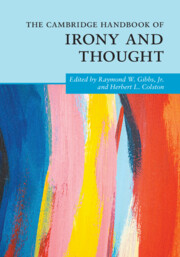Book contents
- The Cambridge Handbook of Irony and Thought
- Cambridge Handbooks in Psychology
- The Cambridge Handbook of Irony and Thought
- Copyright page
- Contents
- Contributors
- Part I Introduction
- Part II The Scope of Irony
- 2 Kinds of Irony: A General Theory
- 3 Irony and Cognitive Operations
- 4 The Varieties of Ironic Experience
- Part III Irony’s Impact
- Part IV Irony in Linguistic Communication
- Part V Irony, Affect, and Related Figures
- Part VI Irony in Expressive, Nonlinguistic Media
- Index
- References
4 - The Varieties of Ironic Experience
from Part II - The Scope of Irony
Published online by Cambridge University Press: 20 December 2023
- The Cambridge Handbook of Irony and Thought
- Cambridge Handbooks in Psychology
- The Cambridge Handbook of Irony and Thought
- Copyright page
- Contents
- Contributors
- Part I Introduction
- Part II The Scope of Irony
- 2 Kinds of Irony: A General Theory
- 3 Irony and Cognitive Operations
- 4 The Varieties of Ironic Experience
- Part III Irony’s Impact
- Part IV Irony in Linguistic Communication
- Part V Irony, Affect, and Related Figures
- Part VI Irony in Expressive, Nonlinguistic Media
- Index
- References
Summary
We experience irony in various ways other than through language. This chapter describes how irony often emerges in different modalities of human expression (e.g., talk, gesture, music, photography, dance, art). People’s conscious realizations that something is irony do not completely capture many unconscious ironic conceptualizations, including acts that are unintentionally ironic. People also sometimes call these out for others to attend to and engage in divergent nonverbal ironic performances, all of which illustrate the importance of bodily experience in ironic thinking, language, and action. Gibbs et al. specifically argue that irony is as much an appraisal process through which people deal with incompatibilities in their varied experiences (i.e., the appraisal theory of irony), as it is a particular type of meaning product. People may not simply possess a single conception of irony that is applicable to all situations in the same way. Individuals may differ, for example, in whether they view two contrasting events as just correlated as opposed to having some causal relationship with one another. The varied ways we think about, and emotionally react to, contrasts between expectations and unfolding realities leads to a family resemblance of both unconscious and conscious realizations of irony.
Keywords
- Type
- Chapter
- Information
- The Cambridge Handbook of Irony and Thought , pp. 60 - 78Publisher: Cambridge University PressPrint publication year: 2023



